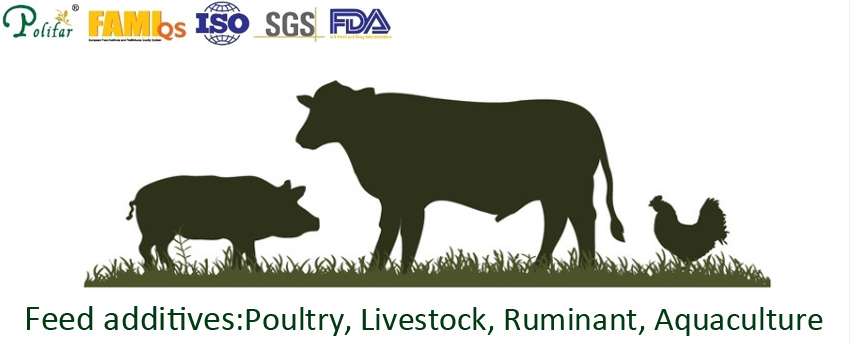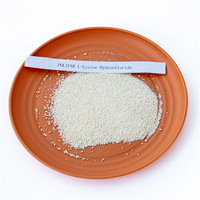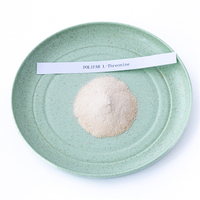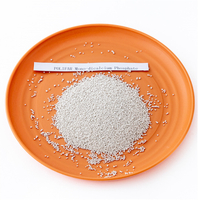| Availability: | |||||||||
|---|---|---|---|---|---|---|---|---|---|
| Color: White crystalline powder Sales Models: wholesale Min Order: 100kg Shelf Life: Two years when properly stored Packing: Net weight 25kg per carton Storage: stockpiled at the ventilated place, avoiding rain, moisture and insolation. Please handle with care to prevent bag damage, store away from toxic substances. | |||||||||
Assay/% 99.0~101.0
POLIFAR
293629

| CAS No.: | 98-92-0 | Other Names: | nicotinamide |
| Molecular formula: | C6H6N2O | EINECS No.: | 202-713-4 |
| Place of Origin: | China | Type: | Feed / food grade vitamin |
| Efficacy: | promote growth | Brand Name: | Polifar |
| Model Number: | feed additives | Appearance: | white powder |
| Shelf Life: | 2 years | MOQ: | 1000kg |
| Sample: | Free,≤500g |
【Product performance】:
Nicotinamide , also known as niacinamide or vitamin B3, is a water-soluble vitamin. The product is white crystalline powder, odorless or nearly odorless, bitter in taste, freely soluble in water or ethanol, and dissolvable in glycerin. Nicotinamide is easy to absorb orally and can be widely distributed in the body, the excess metabolites or prototypes are quickly expelled from urine.
Nicotinamide is part of coenzyme I and coenzyme II plays the role of hydrogen delivery in the biological oxidation respiratory chain, can promote biological oxidation processes and tissue metabolism, maintain normal tissue (especially the skin, digestive tract, and nervous system) integrity has an important role.
In addition, nicotinamide has prevention and treatment of heart block, sinus node function, and anti-fast experimental arrhythmias, nicotinamide can significantly improve the heart rate and atrioventricular block caused by verapamil.
Nicotinamide plays several important roles in poultry nutrition. It is essential for the proper functioning of the digestive and nervous systems in poultry. Nicotinamide is also involved in energy metabolism and can help improve the growth and development of poultry. Additionally, it plays a role in maintaining the health of the skin, feathers, and overall immune function in poultry. Overall, nicotinamide is an important nutrient for the health and well-being of poultry.

| CAS No.: | 98-92-0 | Other Names: | nicotinamide |
| Molecular formula: | C6H6N2O | EINECS No.: | 202-713-4 |
| Place of Origin: | China | Type: | Feed / food grade vitamin |
| Efficacy: | promote growth | Brand Name: | Polifar |
| Model Number: | feed additives | Appearance: | white powder |
| Shelf Life: | 2 years | MOQ: | 1000kg |
| Sample: | Free,≤500g |
【Product performance】:
Nicotinamide , also known as niacinamide or vitamin B3, is a water-soluble vitamin. The product is white crystalline powder, odorless or nearly odorless, bitter in taste, freely soluble in water or ethanol, and dissolvable in glycerin. Nicotinamide is easy to absorb orally and can be widely distributed in the body, the excess metabolites or prototypes are quickly expelled from urine.
Nicotinamide is part of coenzyme I and coenzyme II plays the role of hydrogen delivery in the biological oxidation respiratory chain, can promote biological oxidation processes and tissue metabolism, maintain normal tissue (especially the skin, digestive tract, and nervous system) integrity has an important role.
In addition, nicotinamide has prevention and treatment of heart block, sinus node function, and anti-fast experimental arrhythmias, nicotinamide can significantly improve the heart rate and atrioventricular block caused by verapamil.
Nicotinamide plays several important roles in poultry nutrition. It is essential for the proper functioning of the digestive and nervous systems in poultry. Nicotinamide is also involved in energy metabolism and can help improve the growth and development of poultry. Additionally, it plays a role in maintaining the health of the skin, feathers, and overall immune function in poultry. Overall, nicotinamide is an important nutrient for the health and well-being of poultry.
Testing Item | Standard | Result |
Appearance | White crystalline powder | conforms |
Assay/% | 99.0~101.0 | 99.4 |
Melting Range/(℃) | 128~131 | 129.1~129.2 |
Appearance of Solution | Not more intensely coloured than reference solution BY7 | conforms |
PH | 6.0~7.5 | 6.5 |
Loss On Drying/% | ≤0.5 | <0.5 |
Sulfated Ash/% | ≤0.1 | <0.1 |
Residue on Ignition/% | ≤0.1 | <0.1 |
Testing Item | Standard | Result |
Appearance | White crystalline powder | conforms |
Assay/% | 99.0~101.0 | 99.4 |
Melting Range/(℃) | 128~131 | 129.1~129.2 |
Appearance of Solution | Not more intensely coloured than reference solution BY7 | conforms |
PH | 6.0~7.5 | 6.5 |
Loss On Drying/% | ≤0.5 | <0.5 |
Sulfated Ash/% | ≤0.1 | <0.1 |
Residue on Ignition/% | ≤0.1 | <0.1 |
| Product Storage: | Stockpiled at the ventilated place, avoiding rain, moisture and insolation. Please handle with care to prevent bag damage, store away from toxic substances. |
| Product Packaging: | Net weight 25kg per carton |
| Delivery: | About 1 - 2 week |
| Product Storage: | Stockpiled at the ventilated place, avoiding rain, moisture and insolation. Please handle with care to prevent bag damage, store away from toxic substances. |
| Product Packaging: | Net weight 25kg per carton |
| Delivery: | About 1 - 2 week |
Q1: What is the difference between vitamin B3 and nicotinamide?
Vitamin B3 and nicotinamide are closely related compounds, but they are not the same. Here's the difference between the two:
Chemical Structure: Vitamin B3, also known as niacin, refers to a group of compounds that include nicotinic acid (niacin) and its amide form, nicotinamide (also called niacinamide). Both nicotinic acid and nicotinamide are forms of vitamin B3. Nicotinamide, also known as niacinamide, is the amide form of nicotinic acid. It is derived from nicotinic acid and has a similar structure but with an amide group instead of a carboxylic acid group.
Biological Function: Both vitamin B3 and nicotinamide are essential for various biological processes in the body, including energy metabolism, DNA repair, and cell signaling. Nicotinamide is a precursor of two important coenzymes, nicotinamide adenine dinucleotide (NAD) and nicotinamide adenine dinucleotide phosphate (NADP), which play crucial roles in cellular metabolism and energy production.
Sources: Vitamin B3 is found naturally in various foods, including meat, poultry, fish, whole grains, nuts, and legumes. Nicotinamide can also be obtained from dietary sources, but it is also commonly used as a dietary supplement or added to fortified foods and beverages.
Medical Uses: Both vitamin B3 and nicotinamide are used in medicine to prevent and treat conditions related to vitamin B3 deficiency, such as pellagra. Nicotinamide is also used in skin care products for its anti-inflammatory and skin-repairing properties.
Q2: What is nicotinamide feed grade?
A2: Feed-grade nicotinamide is a specifically formulated additive for animal feed. It is typically synthetic and undergoes special processing and purification to meet the nutritional requirements and safety standards of animal feed. Widely added to the feed of poultry, livestock, and other animals, feed-grade nicotinamide helps maintain their health, promotes growth and development, enhances immunity, and improves productivity.
Q1: What is the difference between vitamin B3 and nicotinamide?
Vitamin B3 and nicotinamide are closely related compounds, but they are not the same. Here's the difference between the two:
Chemical Structure: Vitamin B3, also known as niacin, refers to a group of compounds that include nicotinic acid (niacin) and its amide form, nicotinamide (also called niacinamide). Both nicotinic acid and nicotinamide are forms of vitamin B3. Nicotinamide, also known as niacinamide, is the amide form of nicotinic acid. It is derived from nicotinic acid and has a similar structure but with an amide group instead of a carboxylic acid group.
Biological Function: Both vitamin B3 and nicotinamide are essential for various biological processes in the body, including energy metabolism, DNA repair, and cell signaling. Nicotinamide is a precursor of two important coenzymes, nicotinamide adenine dinucleotide (NAD) and nicotinamide adenine dinucleotide phosphate (NADP), which play crucial roles in cellular metabolism and energy production.
Sources: Vitamin B3 is found naturally in various foods, including meat, poultry, fish, whole grains, nuts, and legumes. Nicotinamide can also be obtained from dietary sources, but it is also commonly used as a dietary supplement or added to fortified foods and beverages.
Medical Uses: Both vitamin B3 and nicotinamide are used in medicine to prevent and treat conditions related to vitamin B3 deficiency, such as pellagra. Nicotinamide is also used in skin care products for its anti-inflammatory and skin-repairing properties.
Q2: What is nicotinamide feed grade?
A2: Feed-grade nicotinamide is a specifically formulated additive for animal feed. It is typically synthetic and undergoes special processing and purification to meet the nutritional requirements and safety standards of animal feed. Widely added to the feed of poultry, livestock, and other animals, feed-grade nicotinamide helps maintain their health, promotes growth and development, enhances immunity, and improves productivity.








